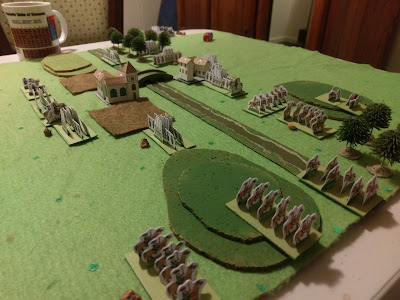This evening I tried another portable wargame, this time using the Ancients rules from the second book to try an ECW battle. Basically I ran the pike and shot as shooting heavy infantry, the horse as a form of heavy cavalry and dragoons as a kind of fast-moving light infantry. I kept changing rules as I played, forgot key things and generally made a dog's breakfast of the whole thing, but it's given me some food for thought and there should be a passable version of the Portable Wargame in there.
I used 3" squares on a 2' x 2' board, with four pike & shot, three horse a dragoon and an artillery unit on each side. Plus a commander each. To be honest for a trial game I probably made the terrain too complicated, and will try an open battlefield next time.
I took a couple of pictures, because a blog post isn't half as interesting without pictures.



I understand that several people are experimenting with ECW versions of the PW rules, mostly using the Ancients rules as a basis.
ReplyDeleteGood luck with your efforts, which I will follow with interest.
All the best,
Bob
Thanks.
DeleteOne thing I keep coming back to is whether close combat is mandatory (i.e. if two units are adjacent they *must* fight if one of them is activated) and also the nature of close combat itself, where the line between attacker and defender is rather blurred.
Have you considered allowing an activated unit adjacent to an enemy to either simply shoot (if it can) using the normal firing mechanisms *or* initiate a close combat? For example, I have a unit in a village, with an adjacent enemy. The enemy, when activated, might attack me because if they win they can move forward and occupy the village. However on my turn I don't necessarily want to risk a close combat, because both units get to roll; I simply want to shoot at the enemy unit. Am I missing unintended consequences by adopting this approach?
Kaptain Kobold,
DeleteIt was my intention that Close Combat NOT be mandatory UNLESS a unit has moved into a grid area that is adjacent to that occupied by an enemy unit in order to initiate that Close Combat.
I specifically did not make it mandatory so that players could choose whether or not to move and fire or move and initiate Close Combat. That is why No.3 in the Turn Sequence states that activated units can do one of three things.
I know that some players choose to make Close Combat mandatory between opposing adjacent units, but the wording allows them to interpret the rules that way if they so choose. (I like players to adapt my rules to suit their requirements ... something that players with a tendency towards lawyer-ism don't like!)
In the example you give in your comment, the enemy may well try to force your unit out of the village by initiating a Close Combat, but if they fail to and both units remain in adjacent grid areas, you are not obliged to return the compliment; you can stay put and fire as per the options in No.3 in the Turn Sequence.
I hope that this makes my intentions regarding this aspect of the rules clearer. As far as I can see, your thinking about how the rules were intended to work is spot-on ... or at least coincides with mine.
All the best,
Bob
Thanks. I will confess that the way you describe it wasn't how I interpreted it as written. The definition of terms in the book on pages 24 and 26 define close combat as being any combat between adjacent grid squares and fire combat as being any combat between non-adjacent units. My thought was that fire combat could be between units in adjacent squares as well, if the unit didn't feel confident of entering into close combat. I asked the question because I was wary of unintended consequences, and suspected you'd thought about it as a possibility already. I see that you have :)
DeleteThe advantage of combat being initiated as on option by the active side is that it clearly defines, for a given combat roll, an attacker and a defender, which makes fine-tuning modifiers more interesting.
Thanks for clarifying that.